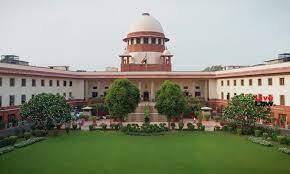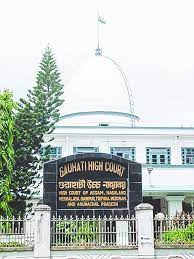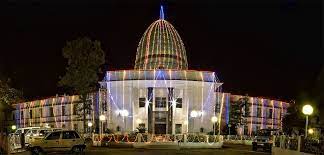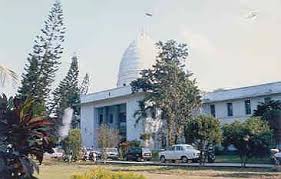These appeals are at the instance of a convict accused sentenced to death for the offence of rape and murder of a 10-year old girl named “X” (Para 1)
Time and again this Court has pointed out that on a reference for confirmation of the sentence of death, the High Court is under an obligation to proceed in accordance with the provisions of Sections 367 and 368 resply of the CrPC. Under these Sections the High Court must not only see whether the order passed by the Sessions Court is correct but it is under an obligation to examine the entire evidence for itself, apart from and independently of the Sessions Court’s appraisal and assessment of that evidence. (Para 2)
There were two rooms and one room, from where dead body was recovered, was in possession of the appellant. (Para 3)
When lock of the room of Munna Pandey (appellant) was opened, dead body of the daughter of the informant was found beneath the bed. The informant claimed that Pritam Tiwary and Munna Pandey (appellant) both after committing rape with her 11 years old daughter by way of throttling had killed her and the dead body was concealed in his room. (Para 3)
The Trial Court framed charge vide order dated 04.11.2015 against the appellant and the co-accused for the offence punishable under Sections 376(2)(g), 302 read with Section 34, 120B of the IPC and Section 4 of the POCSO Act. (Para 6)
The Trial Court treated the case as one falling under the category of “rarest of the rare cases” and sentenced the appellant to death. (Para 10)
Medical examination of the accused u/s 53A of CrPC is required in cases of rape. Even though the Appellant was taken to the hospital for the treatment of his injuries incurred during the time of arrest, he was not subjected to any such medical examination where his samples were collected for the purpose of DNA examination. (Para 13(2.1))
In cases of rape where the victim is dead and the offence is sought to be established only by circumstantial evidence, medical evidence assumes great importance. The failure of the prosecution to subject the appellant to medical examination is fatal to the prosecution’s case. (Chotkau v State of Uttar Pradesh 2022 SCCOnline SC 1313 para 81,82) (Para 13(2.2))
If no DNA examination is conducted and if no reasonable explanation is provided by the prosecution for not conducting a DNA examination, adverse consequences would fall on the prosecution. Moreover, if reasonable grounds for believing that an examination of the accused will not afford evidence as to the commission of an offence, it is quite unlikely that a charge-sheet would even be filed against the accused for committing an offence of rape. (Rajendra Prahladrao Wasnik v State of Maharashtra (2019) 12 SCC 495 para 49-57; Prakash Nishad @ Kewat v State of Maharashtra 2023 SCCOnline SC 666 para 57,58.59) (Para 13(2.3))
However, the prosecution failed to prove if they were sent to the Forensic Science Laboratory for examination. (Para 13(3.1))
Further the vaginal swab of the deceased collected at the time of post-mortem was sent by PW 4, Dr Sandeep Lal to the pathology lab for examination. [Ex 2 (Postmortem report)]. However, the pathological report which states that ‘spermatozoa not found’ was not produced by the prosecution as evidence at the time of trial. (Para 13(3.2))
All the witnesses in their 161 statement stated that the victim was last seen with Pritam Tiwari. However, PW1, PW2 and PW3 in their Court testimony, which was recorded 3 months after Pritam Tiwari was declared a Juvenile by the Juvenile Justice Board [Ex A (order of the JJB)] improved their statement and said that it was Munna Pandey and not Pritam Tiwari. However, this was not corroborated by the independent witness Vijay Sah (PW6). The said improvement on the part of the interested witnesses could be motivated by the fact that Pritam Tiwari (who was caught red handed) was now only going to be subjected to a lenient punishment under the Juvenile Justice Act, 2000 and therefore the Appellant alone remained accused in the subject case. (Para 13(4.1))
There are material contradictions in PW3’s court testimony and her 161 statement. In her 161 statement she states that Pritam Tiwari came to her house at 09:00 am and took the victim along with him to watch TV and after 2 hours she saw Pritam Tiwari locking the grill of the verandah. Whereas in her Court testimony, she states that Munna Pandey was last seen with the victim. PW3 was confronted with this particular contradiction by the defense counsel during her cross- examination but PW3 does not provide any reason for the said contradiction. (Para 13(4.2))
The case on hand is one of a very gruesome rape and murder of a 10-year old girl. (Para 19)
She denied the suggestion that she had given false evidence and falsely implicated the appellant. On examination of entire evidence of P.W.3, it is evident that though this witness was cross-examined at length, nothing could be extracted to create any doubt on her evidence. (Para 20)
Thus, all throughout, the High Court proceeded on the footing that it was the appellant convict who came to the house of the victim in the morning of 31.05.2015 and lured her to come to his house to watch TV. The High Court took the view that since the dead body of the victim was recovered from the room owned by the appellant and he was seen by the PW 3 Priya Kumari locking the door attached to his house, it could be none other than the appellant who could be said to have committed the crime. The High Court completely forgot that there was a co-accused also namely Pritam Tiwari in the picture. Pritam Tiwari being a juvenile was tried in accordance with the provisions of the Juvenile Justice Act, 2015 and was held guilty and sentenced to three years imprisonment. (Para 21)
That following the instructions of her senior officers, she did not take any steps to procure FSL report. Who are these senior officers of PW 5 and why they instructed the PW 5 not to procure the FSL report should have been a subject matter of inquiry by both, the State as well as the trial court. (Para 22)
The aforesaid lapse is just a tip of the iceberg. We are at pains to state that it is a very serious flaw on the part of the investigating officer and that too in such a serious matter. (Para 23)
One another serious flaw in the present case on the part of the investigating officer that has come to our notice is the failure to subject the appellant to medical examination by a medical practitioner. No explanation, much less any reasonable explanation, has been offered for such a serious flaw on the part of the investigating officer. (Para 24)
Thus, medical examination of an accused assumes great importance in cases where the victim of rape is dead and the offence is sought to be established only by circumstantial evidence. FURTHER (Para 29)
Indisputably, none of the aforesaid circumstances relied upon by the Trial Court were put to the appellant convict so that he could offer a proper explanation to the same. (Para 32)
Our mind got clouded with suspicion. Ultimately, we noticed something very shocking. The shocking aspect, we shall discuss about hereinafter, if would have gone unnoticed at our end too, then it would have led to a serious miscarriage of justice. (Para 33)
Thus, the case of all the witnesses before the police was that it was Pritam Tiwari who had come to the house of the victim on the fateful day and date and had taken the victim along with him to his house to watch TV. All the statements further reveal that it was Pritam Tiwari who was found locking the door when the witnesses enquired with Pritam Tiwari about the whereabouts of the victim. (Para 39)
Neither the defence counsel nor the public prosecutor nor the presiding officer of the Trial Court and unfortunately even the High Court thought fit to look into the aforesaid aspect of the matter and try to reach to the truth. (Para 40)
We are sorry to say that the learned defence counsel had no idea how to contradict a witness with his or her police statements in accordance with Section 145 of the Evidence Act, 1872 (for short, ‘Evidence Act’). (Para 41)
The public prosecutor knew that the witnesses were deposing something contrary to what they had stated before the police in their statements recorded under Section 161 of the CrPC. It was his duty to bring to the notice of the witnesses and confront them with the same even without declaring them as hostile. (Para 42)
The presiding officer of the Trial Court also remained a mute spectator. It was the duty of the presiding officer to put relevant questions to these witnesses in exercise of his powers under Section 165 of the Evidence Act. Section 162 of the CrPC does not prevent a Judge from looking into the record of the police investigation. Being a case of rape and murder and as the evidence was not free from doubt, the Trial Judge ought to have acquainted himself, in the interest of justice, with the important material and also with what the only important witnesses of the prosecution had said during the police investigation. (Para 43)
There is in our opinion nothing in Section 162 of the CrPC which prevents a Trial Judge from looking into the papers of the chargesheet suo motu and himself using the statement of a person examined by the police recorded therein for the purpose of contradicting such person when he gives evidence in favour of the State as a prosecution witness. (Para 47)
In our opinion, in a case of the present description where the evidence given in a Court implicates persons who are not mentioned in the first information report or police statements, it is always advisable and far more important for the Trial Judge to look into the police papers in order to ascertain whether the persons implicated by witnesses, at the trial had been implicated by them during the investigation. (Para 48)
What is important to note in the aforesaid decision of this Court is the principle of law that if the witness was not confronted with that part of the statement with which the defence wanted to contradict him, then the Court cannot suo motu make use of statements to police not proved in compliance with Section 145 of the Evidence Act. Therefore, it is of utmost importance to prove all major contradictions in the form of material omissions in accordance with the procedure as established under Section 145 of the Evidence Act and bring them on record. It is the duty of the defence counsel to do so. (Para 50)
According to Section 366 when a Court of Session passes a sentence of death, the proceedings must be submitted to the High Court and the sentence of death is not to be executed unless it is confirmed by the High Court. Section 367 then proceeds to lay down the power of the High Court to direct further enquiry to be made or additional evidence to be taken. Section 368, thereafter, lays down the power of the High Court to confirm the sentence so imposed or annul the conviction. (Para 58)
The position is, however, different where the appeal is by an accused who is sentenced to death, so that the High Court dealing with the appeal has before it, simultaneously with the appeal, a reference for confirmation of the capital sentence under Section 366 of the CrPC. On a reference for confirmation of sentence of death, the High Court is required to proceed in accordance with Sections 367 and 368 respectively of the CrPC and the provisions of these Sections make it clear that the duty of the High Court, in dealing with the reference, is not only to see whether the order passed by the Sessions Judge is correct, but to examine the case for itself and even direct a further enquiry or the taking of additional evidence if the Court considers it desirable in order to ascertain the guilt or the innocence of the convicted person. It is true that, under the proviso to Section 368, no order of confirmation is to be made until the period allowed for preferring the appeal has expired, or, if an appeal is presented within such period, until such appeal is disposed of, so that, if an appeal is filed by a condemned prisoner, that appeal has to be disposed of before any order is made in the reference confirming the sentence of death. In disposing of such an appeal (Para 59)
Truth is the cherished principle and is the guiding star of the Indian criminal justice system. For justice to be done truth must prevail. Truth is the soul of justice. The sole idea of criminal justice system is to see that justice is done. Justice will be said to be done when no innocent person is punished and the guilty person is not allowed to go scot free. (Para 65)
For the dispensation of criminal justice, India follows the accusatorial or adversarial system of common law. In the accusatorial or adversarial system the accused is presumed to be innocent; prosecution and defence each put their case; judge acts as an impartial umpire and while acting as a neutral umpire sees whether the prosecution has been able to prove its case beyond reasonable doubt or not. (Para 66)
If the Courts are to impart justice in a free, fair and effective manner, then the presiding judge cannot afford to remain a mute spectator totally oblivious to the various happenings taking place around him, more particularly, concerning a particular case being tried by him. The fair trial is possible only when the court takes active interest and elicit all relevant information and material necessary so as to find out the truth for achieving the ultimate goal of dispensing justice with all fairness and impartiality to both the parties. (Para 71)
If anyone would ask us the question, “What is the ratio of this Judgment?” The answer to the same would be very simple and plain, in the words of Clarence Darrow; “Justice has nothing to do with what goes on in the courtroom; Justice is what comes out of a courtroom.” (Para 74)
In the result, the impugned judgment of the High Court is set aside and the matter is remitted back to the High Court for reconsideration of the Death Reference No. 4 of 2017 and Criminal Appeal (DB) No. 358 of 2017. The Death Reference No. 4 of 2017 and Criminal Appeal (DB) No. 358 of 2017 stand restored for reconsideration of the High Court in accordance with law. (Para 75)
As the appellant convict is in jail past more than nine years, his family might be in dire straits. He may not be in a position to engage a lawyer of his choice. Probably, he may not be in a position to even understand what is said in this judgment. In such circumstances, the High Court may request a seasoned criminal side lawyer to appear on behalf of the appellant and assist the Court (Para 77)
SUPREME COURT OF INDIA
2023 STPL(Web) 233 SC
[2023 INSC 793]
Munna Pandey Vs. State Of Bihar
Criminal Appeal Nos. 1271-1272 of 2018-Decided on 4-9-2023
https://stpllaw.in/wp-content/uploads/2023/09/2023-STPLWeb-233-SC.pdf







